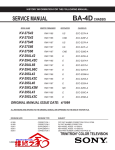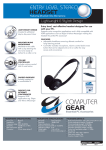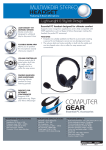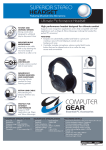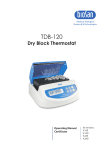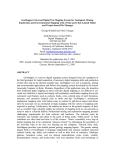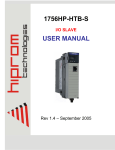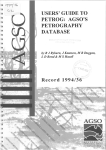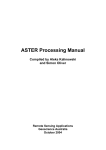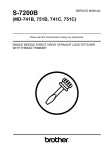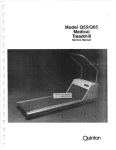Download PowerPoint 2007-2010 template user guide
Transcript
The geology and discovery history of the Resolution porphyry Cu-Mo deposit, Arizona, USA George Steele, Chief Geologist - Base Metals, Rio Tinto Exploration with acknowledgement of all past and present Resolution Project geologists Photo: Resolution Copper Mining Limited Resolution shafts 9 & 10 Resolution deposit – location Source: Resolution Copper Mining Limited SW USA porphyries and total magnetic intensity Source: Hehnke et al., 2012 Resolution deposit – basement terranes Source: Resolution Copper Mining Limited Resolution deposit Proterozoic ENE – trending structural grain Metamorphic “Grain” in basement rocks RESOLUTION Source: Resolution Copper Mining Limited Pioneer [Superior] District - resources Magma Mine (1875) 26Mt @ 4.5% Cu historic Pinto Valley Miami Unit / Capstone Mining 214Mt @ 0.31% Cu leach resource Superior East / RCML (1975) 200Mt @ 0.90% Cu mineral inventory km Source: Resolution Copper Mining Limited Post-mineral cover Laramide intrusives P€, Pz basement N 10 Globe Hills (1874) 12Mt @ 4.3% Cu historic Miami / Freeport McMoRan 60Mt @ 0.47% Cu leach reserve Resolution / RCML (1995) 1,737Mt @ 1.52% Cu + 0.035% Mo inferred resource 0 Carlota / KGHM (1900’s) closing 2013 77Mt @ 0.45% Cu reserve Copper Cities Pinto Valley / Capstone Mining 89Mt @ 0.40% Cu reserve (4 yrs.) 191Mt @ 0.40% Cu resource Ray / Grupo Mexico (1880) 540Mt @ 0.53% Cu + 1.5g/t Ag reserve 212Mt @ 0.27% Cu SX/EW reserve Surface projection Road Resolution deposit footprint Source: Hehnke et al., 2012 Resolution discovery history – early history • The Pioneer Mining District was established in 1875 after discovery of native silver at Silver King 5km north of the town of Superior. • Numerous small workings exploited silver veins in Paleozoic rocks along 8km of outcrop at the foot of Apache Leap. One of the veins, the Silver Queen Vein later became known as the Magma Vein. • In the early 1900s Silver Queen transitioned into a copper producer as supergene silver ores were depleted. Supergene chalcocite transitions into hypogene chalcocite and bornite at depth. • • • Lateral mine development followed the Magma Vein eastward under cover leading to discovery of massive sulphide replacement bodies at favorable horizons within the Paleozoic carbonate wall rocks. In the 1960s mine production focused on the replacement lodes. These supported mining operations until reserve depletion in June 1996. The Magma Vein was eventually exploited along a strike length of 3km and to a depth of 1,500m. Over 85 years the Magma Mine produced 24.5Mt of ore grading almost 5 percent Cu. Source: Manske and Paul, 2002 Silver King Magma replacement bodies Magma vein Superior Resolution 0 2 km Resolution discovery history Surface exploration 1990-98; Magma Copper/BHP • In 1991, recognizing the imminent reserve depletion in the Magma Mine, a districtscale exploration program was launched for additional replacement bodies. • Building on district geologic concepts first formulated in the 1970s, exploration focused under the plateau of Apache Leap in the vicinity of the shaft #9 complex. • In 1991 hole MB-9 was drilled from surface targeting vein mineralisation. • The hole cut leached cap, a thin enrichment zone and weak pyrite-chalcopyrite-specularite mineralisation in chloritesericite alteration and was the first direct indication of (distal) porphyry-style alteration / mineralization. Source: Manske and Paul, 2002 1.5km Resolution discovery history Underground exploration 1994-97; Magma Copper • In October 1994, a subhorizontal drill hole [S27E] was directed southward from the southern most underground mine workings. • This hole intersected 460m @ 0.56% Cu in quartz-sulphide stockworked pervasively sericitised wall rocks. It was surmised that this drill hole had cut across the high structural level of a concealed porphyry center. • In January 1996 a follow-up hole [S27H] inclined beneath the “discovery hole” drilled through the sericitic zone into intensely biotitised rocks returning 43m @ 1.94% Cu and 0.037% Mo. Source: Manske and Paul, 2002 1.5km Resolution discovery history Underground exploration 1994-97; Magma Copper • In October 1994, a subhorizontal drill hole [S27E] was directed southward from the southern most underground mine workings. • This hole intersected 460m @ 0.56% Cu in quartz-sulphide stockworked pervasively sericitized wall rocks. It was surmised that this drill hole had cut across the high structural level of a concealed porphyry center. • In January 1996 a follow-up hole [S27H] inclined beneath the “discovery hole” drilled through the sericitic zone into intensely biotitised rocks returning 43m @ 1.94% Cu and 0.037% Mo. Source: Manske and Paul, 2002 1.5km Resolution discovery history Underground exploration 1996-98; BHP • • • • • • In 1996 BHP acquired Magma Copper and mining operations were closed shortly afterwards. Exploration drilling continued until the end of 1997. In March 1998 a mineral inventory of 415Mt @ 1.66% Cu + 0.02% Mo + 2g/t Ag was announced to the Australian Securities Commission. A 750m long x 250m wide x 300m high body of >1% hypogene Cu was modelled with a best intersection of 306m @ 1.75% Cu + 0.029% Mo. In 1998 the pumps were pulled from #9 shaft and the shaft was flooded. In April 2001 Kennecott (a whollyowned Rio Tinto subsidiary) signed an option to JV agreement with BHP requiring an initial investment of US$25M to earn a 55% interest. *surface hole Source: BHP Billiton resource announcement 1998, Resolution Copper Mining Limited Hole From (m) Length (m) MB-20A* 1704 306 MB-21A* 1548 85 S22B 843 102 S27A 692 245 S27H 850 43 Cu % 1.75 1.88 1.14 1.19 1.95 Mo % 0.029 0.027 0.012 0.024 0.036 Resolution discovery history 2001-03; Rio Tinto • Completed 17 holes in 18 months • Five drill sites • RES-5 returned 352m @ 2.61% Cu & 0.039% Mo • RES-3B returned 595m @ 2.15% Cu & 0.046% Mo Source: Resolution Copper Mining Limited Resolution - regional geology Source: Resolution Copper Mining Limited Resolution deposit – E-W cross section Source: Resolution Copper Mining Limited Resolution stratigraphy Approximate surface projection of the deposit #9 shaft headframe Source: Resolution Copper Mining Limited Resolution stratigraphy – Pinal Schist 1.7Ga Approximate surface projection of the deposit #9 shaft headframe Early Proterozoic Pinal Schist (0%) (%) – wt. percent of material hosted by rock unit within 1% Cu shell Source: Resolution Copper Mining Limited Resolution stratigraphy – Apache Group 1.4Ga Approximate surface projection of the deposit Troy Quartzite #9 shaft headframe Basalt Mescal Limestone Apache Group (15%) (%) – wt. percent of material hosted by rock unit within 1% Cu shell Source: Resolution Copper Mining Limited Dripping Spring Quartzite Pioneer Shale Resolution stratigraphy – Diabase sills 1.1Ga Approximate surface projection of the deposit #9 shaft headframe Diabase sills (36%) (%) – wt. percent of material hosted by rock unit within 1% Cu shell Source: Resolution Copper Mining Limited Diabase Resolution stratigraphy – Palaeozoic rocks Approximate surface projection of the deposit Pennsylvanian Naco Limestone #9 shaft headframe Palaeozoics (8%) Mississippian Escabrosa Limestone Devonian Martin Limestone (%) – wt. percent of material hosted by rock unit within 1% Cu shell Source: Resolution Copper Mining Limited Cambrian Bolsa Quartzite Resolution stratigraphy – Cretaceous rocks Approximate surface projection of the deposit Porphyry intrusions 66-69Ma (U-Pb) #9 shaft headframe Cretaceous Volcaniclastics (16%) (%) – wt. percent of material hosted by rock unit within 1% Cu shell Source: Resolution Copper Mining Limited Lapilli tuff 66-68Ma (U-Pb) Schultz granite 70-62Ma (U-Pb) Resolution stratigraphy – Tertiary cover rocks Approximate surface projection of the deposit #9 shaft headframe Whitetail Conglomerate Oligocene 24 Ma Post Mineral Cover (0%) (%) – wt. percent of material hosted by rock unit within 1% Cu shell Source: Resolution Copper Mining Limited Apache Leach Tuff Miocene 18.6 Ma Propylitic alteration – early stage chlorite epidote illite chlorite epidote, illite montmorillinite epidote pyrite chlorite epidote, pyrite montmorillinite increasing alteration intensity Source: Resolution Copper Mining Limited chlorite epidote, illite montmorillinite pyrite Potassic alteration – early stage Qtz veins with k-spar halos • biotite ± k-feldspar ± anhydrite ± magnetite • chalcopyrite + molybdenite + pyrite ± bornite • Ar-Ar (secondary biotite) yields 62-63 Ma ages Rhyodacite Porphyry Diabase Source: Resolution Copper Mining Limited Porphyry Phyllic alteration - intermediate stage • quartz + sericite ± kaolinite Rhyodacite porphyry • early chalcopyrite + pyrite • late chalcocite - digenite ± bornite ± pyrite • Ar-Ar (sericite) ages of 62-63 Ma Diabase Diabase Source: Resolution Copper Mining Limited Advanced argillic alteration – late stage • kaolinite + dickite ± topaz ± quartz (± pyrite ± alunite ± zunyite) zunyite, topaz • chalcocite - digenite + bornite ± covellite + pyrite • Ar-Ar hypogene alunite 60-62 Ma topaz dickite Source: Resolution Copper Mining Limited Alteration of limestones - skarns • Prograde (anhydrous skarn) garnet ± diopside ± magnetite • Retrograde (hydrous skarn) tremolite ± actinolite ± chlorite ± epidote ± hematite ± chalcopyrite Source: Resolution Copper Mining Limited Temporal relationships between intrusions (16%) Truncated veins Rhyodacite • 3 families of porphyries based on U-Pb dates of 66-69Ma. Rhyodacite Quartz latite Crowded latite porphyry (minor) • Porphyries appear to be pre- to early-mineral RES-009A 2278m Quartz-latite High grade host rocks – skarn and diabase Skarn Diabase Source: Resolution Copper Mining Limited High grade host rocks – hydrothermal breccias • pre- to very early-mineral • pre- and post-porphyry • breccias host 10% of the resource Source: Resolution Copper Mining Limited Host rock control on alteration and mineralisation Geochemically inert lithologies i.e. quartzite, felsic intrusives - No fluid buffering capacity - Cu remains mobile - Host to high Mo grades Quartzite Quartzite cobble Kvs tuffaceous conglomerate Source: Resolution Copper Mining Limited Main-stage hypogene chalcopyrite • b Vein & fracture infill Skarn Source: Resolution Copper Mining Limited Breccia replacement Hypogene overprinting • Progressive sulphidation as fluids evolve • Assemblages include bornite, digenite, chalcocite, covellite and pyrite cp py cc, bn py Source: Resolution Copper Mining Limited Hypogene overprinting – high grade breccia Chalcopyrite only Chalcocite + pyrite Molybdenite • Molybdenum (350 ppm) • Most quartz-molybdenite veins are associated with transitional K silicate – QSP alteration. • Classic “B” veins of Gustafson and Hunt (1975). • Re-Os ages of 64-65 Ma RES-004B, 1,757m Rhyodacite porphyry 1.3% Cu, 0.3% Mo Quartzite Source: Resolution Copper Mining Limited Supergene processes • Leached cap 30-250m thick • Hematite-goethite rich with local native Cu Base of oxidation • No significant secondary chalcocite • No secondary oxide minerals Native Cu Source: Resolution Copper Mining Limited Resolution – geology, alteration and mineralisation Source: Hehnke et al., 2012 Resolution >0.5% copper shell Source: Resolution Copper Mining Limited Resolution >1.5% copper shell Source: Resolution Copper Mining Limited Resolution >2% copper shell Source: Resolution Copper Mining Limited Resolution Resource 2012 JORC Inferred Resource 1.737 Bt @ 1.52% Cu & 0.035% Mo Source: Resolution Copper Mining Limited Why is the hypogene grade of Resolution so high? • Favourable host rocks; diabase and limestone (hosting 47% of mineralization) cf. El Teniente, Hugo Dummett • Fluid flux focused through centrally located pre- and syn-mineral breccias that provided conduits through sub-horizontal diabase sills. • Absence of late (diluting) intrusions and breccias cf. Chuquicamata • Multiple phases of copper addition? cf. Hugo Dummett










































